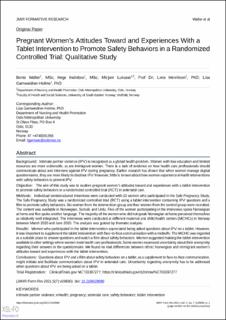Pregnant Women's Attitudes Toward and Experiences With a Tablet Intervention to Promote Safety Behaviors in a Randomized Controlled Trial: Qualitative Study
Peer reviewed, Journal article
Published version
Permanent lenke
https://hdl.handle.net/11250/2786704Utgivelsesdato
2021-07-20Metadata
Vis full innførselSamlinger
Originalversjon
https://doi.org/10.2196/28680Sammendrag
Background: Intimate partner violence (IPV) is recognized as a global health problem. Women with low education and limited resources are more vulnerable, as are immigrant women. There is a lack of evidence on how health care professionals should communicate about and intervene against IPV during pregnancy. Earlier research has shown that when women manage digital questionnaires, they are more likely to disclose IPV. However, little is known about how women experience eHealth interventions with safety behaviors to prevent IPV. Objective: The aim of this study was to explore pregnant women’s attitudes toward and experiences with a tablet intervention to promote safety behaviors in a randomized controlled trial (RCT) in antenatal care. Methods: Individual semistructured interviews were conducted with 10 women who participated in the Safe Pregnancy Study. The Safe Pregnancy Study was a randomized controlled trial (RCT) using a tablet intervention containing IPV questions and a film to promote safety behaviors. Six women from the intervention group and four women from the control group were recruited. The content was available in Norwegian, Somali, and Urdu. Five of the women participating in the interviews spoke Norwegian at home and five spoke another language. The majority of the women who did not speak Norwegian at home perceived themselves as relatively well integrated. The interviews were conducted at different maternal and child health centers (MCHCs) in Norway between March 2020 and June 2020. The analysis was guided by thematic analysis. Results: Women who participated in the tablet intervention appreciated being asked questions about IPV on a tablet. However, it was important to supplement the tablet intervention with face-to-face communication with a midwife. The MCHC was regarded as a suitable place to answer questions and watch a film about safety behaviors. Women suggested making the tablet intervention available in other settings where women meet health care professionals. Some women expressed uncertainty about their anonymity regarding their answers in the questionnaire. We found no real differences between ethnic Norwegian and immigrant women’s attitudes toward and experiences with the tablet intervention. Conclusions: Questions about IPV and a film about safety behaviors on a tablet, as a supplement to face-to-face communication, might initiate and facilitate communication about IPV in antenatal care. Uncertainty regarding anonymity has to be addressed when questions about IPV are being asked on a tablet.

